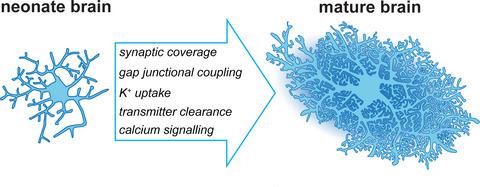当前位置:
X-MOL 学术
›
Eur. J. Nerosci.
›
论文详情
Our official English website, www.x-mol.net, welcomes your feedback! (Note: you will need to create a separate account there.)
Astrocytes of the early postnatal brain
European Journal of Neroscience ( IF 3.4 ) Pub Date : 2020-05-14 , DOI: 10.1111/ejn.14780 Lisa Felix 1 , Jonathan Stephan 1 , Christine R Rose 1
European Journal of Neroscience ( IF 3.4 ) Pub Date : 2020-05-14 , DOI: 10.1111/ejn.14780 Lisa Felix 1 , Jonathan Stephan 1 , Christine R Rose 1
Affiliation

|
In the rodent forebrain, the majority of astrocytes are generated during the early postnatal phase. Following differentiation, astrocytes undergo maturation which accompanies the development of the neuronal network. Neonate astrocytes exhibit a distinct morphology and domain size which differs to their mature counterparts. Moreover, many of the plasma membrane proteins prototypical for fully developed astrocytes are only expressed at low levels at neonatal stages. These include connexins and Kir4.1, which define the low membrane resistance and highly negative membrane potential of mature astrocytes. Newborn astrocytes moreover express only low amounts of GLT-1, a glutamate transporter critical later in development. Furthermore, they show specific differences in the properties and spatio-temporal pattern of intracellular calcium signals, resulting from differences in their repertoire of receptors and signalling pathways. Therefore, roles fulfilled by mature astrocytes, including ion and transmitter homeostasis, are underdeveloped in the young brain. Similarly, astrocytic ion signalling in response to neuronal activity, a process central to neuron–glia interaction, differs between the neonate and mature brain. This review describes the unique functional properties of astrocytes in the first weeks after birth and compares them to later stages of development. We conclude that with an immature neuronal network and wider extracellular space, astrocytic support might not be as demanding and critical compared to the mature brain. The delayed differentiation and maturation of astrocytes in the first postnatal weeks might thus reflect a reduced need for active, energy-consuming regulation of the extracellular space and a less tight control of glial feedback onto synaptic transmission.
中文翻译:

出生后早期大脑的星形胶质细胞
在啮齿动物前脑中,大部分星形胶质细胞是在出生后早期产生的。分化后,星形胶质细胞随着神经元网络的发育而成熟。新生儿星形胶质细胞表现出与成熟星形胶质细胞不同的独特形态和结构域大小。此外,许多完全发育的星形胶质细胞原型的质膜蛋白仅在新生儿阶段以低水平表达。这些包括连接蛋白和 Kir4.1,它们定义了成熟星形胶质细胞的低膜电阻和高负膜电位。此外,新生星形胶质细胞仅表达少量 GLT-1,这是一种在发育后期至关重要的谷氨酸转运蛋白。此外,它们显示出细胞内钙信号的特性和时空模式的特定差异,由于受体和信号通路的不同而导致的。因此,成熟星形胶质细胞所扮演的角色,包括离子和递质稳态,在年轻的大脑中发育不全。类似地,响应神经元活动的星形胶质细胞离子信号传导是神经元 - 胶质细胞相互作用的核心过程,在新生儿和成熟大脑之间有所不同。这篇综述描述了星形胶质细胞在出生后最初几周的独特功能特性,并将它们与发育后期进行了比较。我们得出的结论是,与成熟的大脑相比,由于神经元网络不成熟和细胞外空间更宽,星形胶质细胞的支持可能没有那么苛刻和关键。因此,产后最初几周星形胶质细胞的分化和成熟延迟可能反映了对活跃、
更新日期:2020-05-14
中文翻译:

出生后早期大脑的星形胶质细胞
在啮齿动物前脑中,大部分星形胶质细胞是在出生后早期产生的。分化后,星形胶质细胞随着神经元网络的发育而成熟。新生儿星形胶质细胞表现出与成熟星形胶质细胞不同的独特形态和结构域大小。此外,许多完全发育的星形胶质细胞原型的质膜蛋白仅在新生儿阶段以低水平表达。这些包括连接蛋白和 Kir4.1,它们定义了成熟星形胶质细胞的低膜电阻和高负膜电位。此外,新生星形胶质细胞仅表达少量 GLT-1,这是一种在发育后期至关重要的谷氨酸转运蛋白。此外,它们显示出细胞内钙信号的特性和时空模式的特定差异,由于受体和信号通路的不同而导致的。因此,成熟星形胶质细胞所扮演的角色,包括离子和递质稳态,在年轻的大脑中发育不全。类似地,响应神经元活动的星形胶质细胞离子信号传导是神经元 - 胶质细胞相互作用的核心过程,在新生儿和成熟大脑之间有所不同。这篇综述描述了星形胶质细胞在出生后最初几周的独特功能特性,并将它们与发育后期进行了比较。我们得出的结论是,与成熟的大脑相比,由于神经元网络不成熟和细胞外空间更宽,星形胶质细胞的支持可能没有那么苛刻和关键。因此,产后最初几周星形胶质细胞的分化和成熟延迟可能反映了对活跃、



























 京公网安备 11010802027423号
京公网安备 11010802027423号